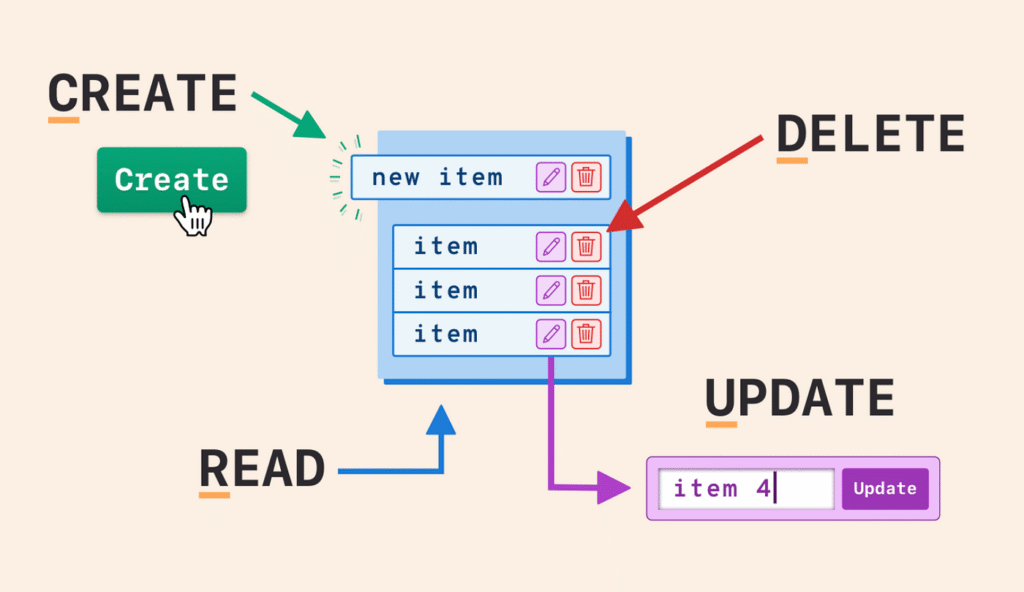When I’m learning something new, I like to talk myself through it—out loud—until it actually clicks. You can tell when you’re just nodding along without understanding, pretending everything’s clear just because no one else is questioning you. That little internal voice says, “Yeah, yeah, REST, CRUD… totally simple.” But is it really?
This was one of those times. I was working through a concept that is simple—but only once you talk it out and break it down.
Here’s where it got tricky for me, and probably for a lot of people: CRUD has four operations, but RESTful architecture has seven standard actions. That mismatch can feel confusing at first. So let’s clear it up.
Start by categorizing them: Are you consuming data or feeding it?
Read is about consuming
Create, Update, and Delete are all about feeding data into the system
Breaking Down CRUD

- Create is pretty self-explanatory—you’re adding something new. A post, a user profile, a product listing, an event… anything.
- Read is retrieving or displaying data. This one has the most RESTful actions associated with it.
- Update means changing existing data—fixing a typo, modifying your settings, that kind of thing.
- Delete is… well, deleting. No explanation needed. (Though honestly, it deserves its own article.)
- So yeah—Create, Read, Update, Delete. CRUD. Nice and tidy.
Mapping CRUD to RESTful Actions
Here are the seven RESTful actions:
- Create
- Index
- New
- Show
- Edit
- Update
- Delete
They don’t map one-to-one to CRUD, but if you look closer, you’ll see how they overlap. Most of the RESTful actions actually fall under the Read category.
Read More: American Express Card Levels Explained: Comprehensive 2025 Guide
Let’s go through a simple flow—say, signing up on a social network:
You visit the homepage and click Create Account. You’re taken to a form where you can input your name, email, etc. This is action #3: New—it’s a Read operation, because it’s displaying the form to create something new.

Once you fill out the form and submit it, action #1: Create kicks in. Your data is sent to the server and saved.
Now you’re redirected to your shiny new profile page. This is action #4: Show, where the system reads and displays a specific entry from the database—your user profile.
You admire your profile picture and bio… until you spot a problem. You accidentally typed “Narc” instead of “Marc.” Oops.
You click the little pencil icon—action #5: Edit. This shows a form pre-filled with your info, allowing you to change it. Again, this is a Read operation—just displaying the edit form.
You correct your name and hit save. That’s action #6: Update—feeding the server new data to replace the old entry.
All set. Now you want to see who else is on the platform. You click “Find Friends” or something similar. The site responds with action #2: Index, listing user profiles from the database. Another Read operation, just showing a list instead of a single entry.
Then it hits you. It’s Sunday, 2 a.m., and you’re slightly tipsy—suddenly realizing you created a profile on the wrong social network. Classic.
No worries. You head to your dashboard, hit the “Delete Profile” button, and boom—action #7: Delete does its job. Goodbye profile.
Slightly embarrassed but kind of proud, you call it a night. You might’ve made a questionable choice by signing up mid-buzz, but at least you understand CRUD now—and that’s a win.
Conclusion
Understanding the relationship between CRUD operations and RESTful actions is a foundational step in mastering web development. While CRUD simplifies things into four basic data operations—Create, Read, Update, Delete—RESTful actions break these down into more specific behaviors that align with how users interact with web applications. By talking through each step and connecting it to a real-world example, such as creating and managing a user profile, the abstract becomes tangible. Once you see how actions like New, Show, Edit, and Index all fall under Read, the confusion starts to clear. With this clarity, RESTful design no longer feels overwhelming—it becomes a logical extension of how users experience and interact with digital systems.
